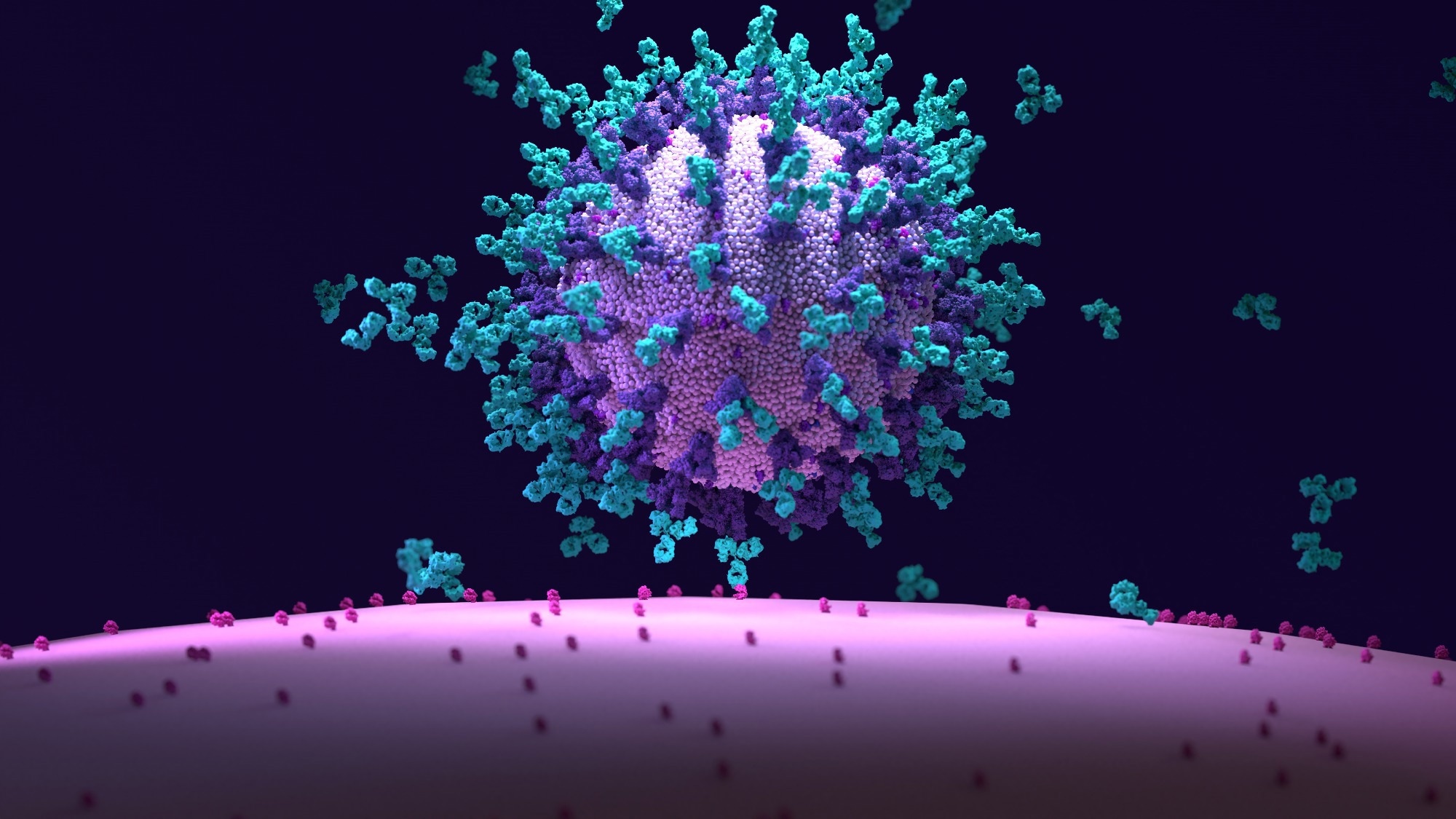In a recent study posted to bioRxiv* preprint server, researchers in the United States identified several potent pan-coronavirus (CoV) inhibitors.
CoVs are single-stranded, positive-sense, enveloped RNA viruses from the Coronaviridae family. The viral life cycle begins with the attachment of a trimeric spike to cells, which is cleaved by furin-like proteases into S1 and S2 subunits. The virus uses S1’s receptor-binding domain (RBD) for binding to the host cell receptor, angiotensin-converting enzyme 2 (ACE2).
The spike is exposed on the viral surface and is the primary target for developing vaccines and neutralizing antibodies (nAbs). However, the RBD is less conserved among CoVs. Consequently, nAbs against SARS-CoV poorly cross-react with SARS-CoV-2. Moreover, the RBD harbors many mutations, some of which decrease the efficacy of antibodies and vaccines. Thus, RBD might not be ideal for developing pan-CoV inhibitors.
 Study: Discovery of highly potent small molecule pan-coronavirus fusion inhibitors. Image Credit: Design_Cells / Shutterstock
Study: Discovery of highly potent small molecule pan-coronavirus fusion inhibitors. Image Credit: Design_Cells / Shutterstock

 *Important notice: bioRxiv publishes preliminary scientific reports that are not peer-reviewed and, therefore, should not be regarded as conclusive, guide clinical practice/health-related behavior, or treated as established information.
*Important notice: bioRxiv publishes preliminary scientific reports that are not peer-reviewed and, therefore, should not be regarded as conclusive, guide clinical practice/health-related behavior, or treated as established information.
The study and findings
In the present study, researchers reported small molecules with inhibitory activity against SARS-CoV, SARS-CoV-2, and middle-east respiratory syndrome (MERS)-CoV. First, they screened a set of carboxylic acid (COOH)-containing molecules, henceforth denoted NBCoVs, and identified 20 compounds that were not pan-assay interference compounds (PAINS).
The antiviral activity of these NBCoVs was evaluated in two cell lines, 293T-ACE2 and A549-AT cells, infected with SARS-CoV-2 WA-1 pseudoviruses pre-treated with increasing concentrations of NBCoVs. In parallel, the 50% cytotoxicity concentration (CC50) was also evaluated in both cell lines. One of the compounds, NBCoV63, exhibited a half-maximal inhibitory concentration IC50 of 80 nM and 55 nM in 293T-ACE2 and A549-AT cells, respectively, and a CC50 of 50 μM in both cell lines.
NBCoV35 and NBCoV37 exhibited low nanomolar activities in both cell lines. NBCoV37 was more cytotoxic to 293T-ACE2 cells, while NBCoV35 had comparable cytotoxicity in both cell types. The antiviral activity of NBCoV36 was weaker than the other three molecules. The remaining molecules had no/little anti-CoV activity.
Further, the team tested the effectiveness of best-performing NBCoVs (35, 36, 37, and 83) against pseudoviruses of SARS-CoV-2 D614G and Gamma, Delta, and Omicron BA.1 and BA.4/5 variants of concern (VOCs). NBCoV63 was the most potent against tested SARS-CoV-2 variants, with IC50 values of 34 – 96 nM and 26 – 105 nM in 293T-ACE2 and A549-AT cells, respectively.
NBCoV35 best inhibited Omicron BA.4/5 in both cell lines but was weaker against Gamma. NBCoV37 also showed antiviral activity against all tested variants, while NBCoV36 had lower activity. Moreover, the team tested these compounds in Calu-3 cells, permissive to SARS-CoV, MERS-CoV, and SARS-CoV-2. Calu-3 cells were infected with the SARS-CoV-2 WA-1 strain or the Omicron BA.4/5 variant.
As earlier, NBCoV63 retained its excellent anti-CoV activity against both, whereas NBCoVs 35 – 37 had higher IC50 values in Calu-3 cells than in other cell lines. The NBCoVs were also evaluated for activity against pseudoviruses of SARS-CoV and MERS-CoV. Again, NBCoV63 was the most potent inhibitor against SARS-CoV and MERS-CoV. NBCoVs (35 – 37) also had anti-SARS-CoV activity.
By contrast, NBCoV35 and NBCoV36 were less potent against MERS-CoV, but NBCoV37 was highly potent. The team selected NBCoV63 based on the results and tested its activity against live SARS-CoV-2 Hong Kong (HK) isolate, Delta, and Omicron in the conventional plaque-reduction assay. The IC50 values of NBCoV63 were lower for the HK isolate and Delta variant but higher against Omicron than those of the control compound, remdesivir.
The team noted that NBCoV63 also blocked SARS-CoV-2-mediated cell-cell fusion, indicating its ability to disrupt SARS-CoV-2 spike-ACE2 binding and cell-cell fusion. The glide-based docking of the prefusion spike with an active NBCoV63 or inactive NBCoV66 revealed salt-bridges/hydrogen bonds between the COOH moiety of NBCoV63 and K947 and K776 residues of the spike.
These interactions between NBCoV66 and spike were lacking due to the absence of COOH moiety in the inhibitor. These findings were validated using pseudoviruses with single mutations (K947D, K776D, K947L, or K776L). This revealed no antiviral activity of NBCoV36 and NBCoV37 against all mutants at the highest concentration tested. In contrast, IC50 values of NBCoV63 and NBCoV35 were more than 15-fold elevated against mutants relative to wild-type pseudovirus.
Finally, the team examined the absorption, distribution, metabolism, and excretion (ADME) profile of NBCoV63, evaluated by a company, Cyprotex US, LLC. Data suggested that NBCoV63 was less soluble and a low-clearance compound, with a half-life greater than 180 minutes. It was 99.5% plasma protein-bound and highly tolerant to cytochrome P 450 (CYP)-mediated metabolism.
Conclusions
In sum, the team identified NBCoV63 as a pan-CoV inhibitor with consistently high potency against SARS-CoV, MERS-CoV, and SARS-CoV-2 and its VOCs. Notably, it was similarly as effective as remdesivir against the SARS-CoV-2 HK isolate and Delta variant but less effective against the Omicron variant. It also inhibited SARS-CoV-2-mediated cell-cell fusion in a dose-dependent manner. ADME data revealed drug-like properties, but its solubility needs improvement.

 *Important notice: bioRxiv publishes preliminary scientific reports that are not peer-reviewed and, therefore, should not be regarded as conclusive, guide clinical practice/health-related behavior, or treated as established information.
*Important notice: bioRxiv publishes preliminary scientific reports that are not peer-reviewed and, therefore, should not be regarded as conclusive, guide clinical practice/health-related behavior, or treated as established information.